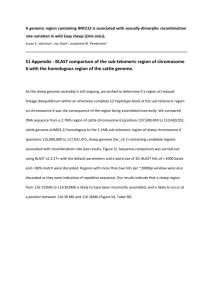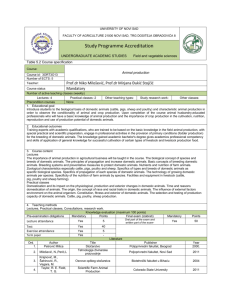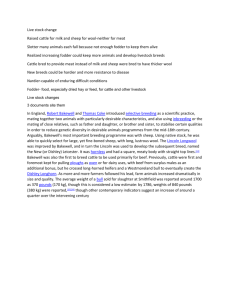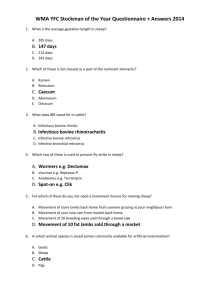Kormagefia - Ethiopia Wide
advertisement
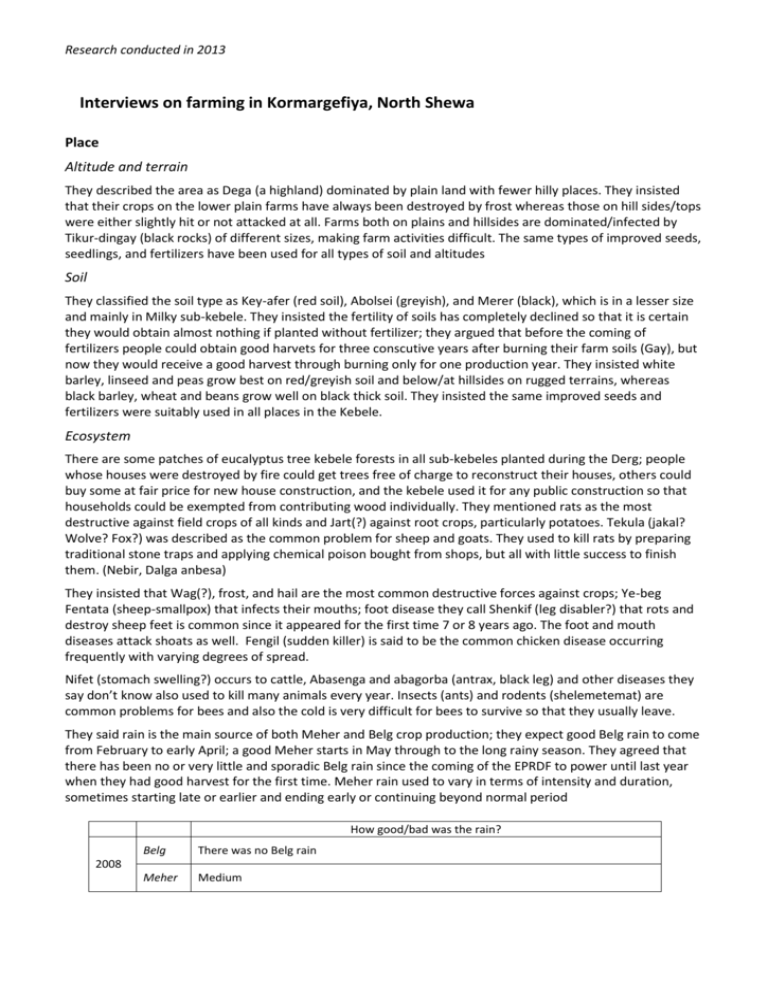
Research conducted in 2013 Interviews on farming in Kormargefiya, North Shewa Place Altitude and terrain They described the area as Dega (a highland) dominated by plain land with fewer hilly places. They insisted that their crops on the lower plain farms have always been destroyed by frost whereas those on hill sides/tops were either slightly hit or not attacked at all. Farms both on plains and hillsides are dominated/infected by Tikur-dingay (black rocks) of different sizes, making farm activities difficult. The same types of improved seeds, seedlings, and fertilizers have been used for all types of soil and altitudes Soil They classified the soil type as Key-afer (red soil), Abolsei (greyish), and Merer (black), which is in a lesser size and mainly in Milky sub-kebele. They insisted the fertility of soils has completely declined so that it is certain they would obtain almost nothing if planted without fertilizer; they argued that before the coming of fertilizers people could obtain good harvets for three conscutive years after burning their farm soils (Gay), but now they would receive a good harvest through burning only for one production year. They insisted white barley, linseed and peas grow best on red/greyish soil and below/at hillsides on rugged terrains, whereas black barley, wheat and beans grow well on black thick soil. They insisted the same improved seeds and fertilizers were suitably used in all places in the Kebele. Ecosystem There are some patches of eucalyptus tree kebele forests in all sub-kebeles planted during the Derg; people whose houses were destroyed by fire could get trees free of charge to reconstruct their houses, others could buy some at fair price for new house construction, and the kebele used it for any public construction so that households could be exempted from contributing wood individually. They mentioned rats as the most destructive against field crops of all kinds and Jart(?) against root crops, particularly potatoes. Tekula (jakal? Wolve? Fox?) was described as the common problem for sheep and goats. They used to kill rats by preparing traditional stone traps and applying chemical poison bought from shops, but all with little success to finish them. (Nebir, Dalga anbesa) They insisted that Wag(?), frost, and hail are the most common destructive forces against crops; Ye-beg Fentata (sheep-smallpox) that infects their mouths; foot disease they call Shenkif (leg disabler?) that rots and destroy sheep feet is common since it appeared for the first time 7 or 8 years ago. The foot and mouth diseases attack shoats as well. Fengil (sudden killer) is said to be the common chicken disease occurring frequently with varying degrees of spread. Nifet (stomach swelling?) occurs to cattle, Abasenga and abagorba (antrax, black leg) and other diseases they say don’t know also used to kill many animals every year. Insects (ants) and rodents (shelemetemat) are common problems for bees and also the cold is very difficult for bees to survive so that they usually leave. They said rain is the main source of both Meher and Belg crop production; they expect good Belg rain to come from February to early April; a good Meher starts in May through to the long rainy season. They agreed that there has been no or very little and sporadic Belg rain since the coming of the EPRDF to power until last year when they had good harvest for the first time. Meher rain used to vary in terms of intensity and duration, sometimes starting late or earlier and ending early or continuing beyond normal period How good/bad was the rain? Belg There was no Belg rain Meher Medium 2008 Belg NONE Meher Medium Belg NONE Meher Medium Belg Very good Meher Good Belg Almost none Meher Very good 2009 2010 2011 2012 Climate change Year Belg rain Meher rain 2001EC Less than expected average 2002EC Less than expected average 2003EC Less than expected average 2004EC More than expected Average 2005EC Less than expected Not yet Unexpected rain Heat Frost Wind describe Average average average average Untimely rain in October average average average average average average average average More than expected More than expected average They insisted that cold, heat, and wind were not at all constant year after year. The coldest months are October to January; the hottest months are February to April; strongly windy months are May and June. They argued that the cold has increasingly become colder and the heat has become hotter, and changing in intensity daily or monthly; too cold early in the morning and from the evening through the night; too hot around/at noon. They indicated that when the freezing cold of the night meets the morning heat, it creates wind and crops are hit and destroyed by frost. Land Land for smallholder farming They agreed that most of the kebele land is covered by individual household farms. They insisted that this didn’t change much except that about 15 Timad of grazing land was given to a youth cooperative that grows irrigated vegetables; an outside investor they don’t know was given around 5 ha of land from a communal area reserved for youth for dairy cows at Kabigizaw Got. They indicated that at the Derg era villagization site in Kabgizaw Got, a town like settlement is growing as people are increasingly constructing houses on their own land/others farm land through exchange. Access to land They insisted that there are no landless households as the minimum land holding is two Timad. They reported that some young people were given land from communal/Mote-keda kebele farmland for houses or farming, but there weren’t any community-wide redistributions since the first one. They said long-term lease was not 2 common as the short-term (3-5 yrs) is. They argued sharecropping is not common as the majority have enough own land to manage except a few weaker people who give land for share cropping. Crops All crops They put grain crops grown according to importance: barley, broad bean, wheat, then linseed, lentils, peas and Sinar (oats); there is around 50 Timads of irrigated land in Milki and Kabgzaw Gots (15 timad in Kabgzaw using spring water and the rest in Milki using spring/swamp sourced river). The common crops grown on irrigated land include broad beans and peas, but vegetables and root crops are grown dominantly, potatoes, carrots, onions, tomatoes (we have verified that potatoes were the dominant crop on the irrigated fields we visited). Generally, they reported that one-third of the farmers use improved wheat seeds from the service coop, with many buying or exchanging from farmers’ previous produce, or using their own previous product (2nd, 3rd generation seeds). The DAs used to provide advice on the technical aspects of production, marketing and facilitate access to seeds on credit or cash; the local agricultural research center (former ELCA) provides improved seeds for demonstration on farmers’ plots (barley, wheat, broad beans, and potatoes) the local NGO, Food for Children also started last year providing improved seeds of potatoes and apples. Linseed is the only oilseed grown in the Kebele. It is being produced in a smaller size of which the greater part is sold at Debrebrhan market; lentil is the only other crop grown in smaller size and all that is left from consumption is sold in the market at higher price (up to 2000 birr to 100 kg). spices, chat, fruits are not grown in the Kebele at all. New crops They insisted there has been no new crop introduced, except apple fruit seedlings provided to many farmers by Food for Children 6 years ago. They argued most of the seedlings dried up due to a lack of water and only a few of those who planted it have one or two trees left; one of the discussants said he has one tree left out of 10 he planted, currently bearing four or five fruits. They insisted there has been no plant/seed that has had any negative effect. Declining crops They argued that Sinar (wild oat) is the only declining crop in the area since the DAS and officials have been advising farmers to abandon growing it because it is not productive, has little market and nutritional value. But farmers appreciate it for providing straw for livestock, requiring very little rain, and growing well without fertilizers. Subsistence crops They insisted that barley, broad beans, and wheat have always remained the most important subsistence crops respectively. They all agreed barley is the most useful product for household consumption, for Injera and Tella (food and local beer). One of them described it ‘as king of all grains’ the other called it; Ye-bet miseso (the pole of households) Cash crops Change They insisted that Eucalyptus trees are the dominant product grown by everyone in the community for the market, whereas potatoes and carrots are important sources of money for irrigators. They reported that irrigators were dominantly planting onions as good market products 8 or 9 years ago until root diseases started to destroy them. Currently, Potatoes are said to be an important cash crop for irrigators and they are being produced in larger amounts. However, discussants argued that there wasn’t a single crop people specifically produced for the market, rather they produced all primarily for home consumption and sell what is left; lentils and linseed were the most common products people sold at higher prices in the last 6 or 5 years 3 compared to before 2003. They insisted that the importance of lentil and linseeds as source of cash and its production scale has been varying from one production year to another depending on whether there is a good harvest (good rain and no pest attack), but the market price is now very much greater than in 2003. They insisted that although people understood that the prices of lentils, linseed, and broad beans have been increasing their production didn’t increase much due to high frost damage against beans, and because people didn’t want to reduce the land size of food crops (barley, wheat) by planting lentils or linseed. A limited amount of these crops is enough for home consumption as food additives Eucalyptus Trees Eucalyptus tree production They reported that eucalyptus trees are a source of cash and they have been planted on hillsides, and nonarable places and in fewer cases also on less productive farmlands; people are increasingly planting these trees so more and more land is being allocated for its plantation year after year. They insisted that most of the people use almost all their eucalyptus trees as a source of money selling at whole sale price on the farm or they cut a few trees at a time so as to split and take to the market and sell at retail price as the need arises. They use only a little of the wood for fuel, house construction or fencing purposes. They indicated that the main risks of eucalyptus trees are they can use up underground water, prevent the growth of crops around the trees, and also the trees shelter crop eating birds. Commonly, the trees are planted on rugged land where it is difficult for the oxen, so adult and young males prepare the land by digging with hoes and plant it during the long rainy season; sometimes it is planted on plots of used up farmland or new flat plots by ploughing with oxen. Eucalyptus tree inputs They used household nursery seedlings bought or self-prepared, watering it with buckets from springs or rivers. There are no special seeds and no fertilizers used as input to grow eucalyptus trees. Eucalyptus tree sales Split and chopped) wood is almost daily taken and sold in Debrebrhan town, negotiating with buyers on the streets as they go through with their loads on donkey backs or at open markets weekly on market days. Licenced wood traders from Debirebrhan town come and buy trees in bulk on the farm, cutting them and transporting by trucks to store and sell in the town. Potatoes Potato production They reported that irrigators have been allocating more land to plant Potatoes as the dominant irrigated crop and currently people commonly allocate more than 70% of their irrigable land for potatoes; more than 95% of irrigated potatoes are sold in Debrebirhan, very small amounts consumed by growers themselves and by other households buying or through gift. Unexpected drops in prices and diseases were reported as problems encountered sometimes. Pump watering and canal water activities are managed by adult males; weeding and harvesting could be done by male, female, young and adult members of households. Potato inputs They reported that only few irrigators use improved seeds as they are expensive, rather the majority use local seeds from their own stock or buy from other producers or in the market. They reported that in the past many people used improved seeds from NGOs or government, but there are now many more potatoes being produced so that people can easily buy from the market or use from on farm products as seeds. They said irrigators including the youth cooperatives didn’t get any credit from any source; the DAs always advise farmers to use irrigation and produce twice in a year and promised to find them markets or create market linkages with urban consumer cooperatives to sell their vegetables, but the Wereda didn’t provide them with any resources; irrigators have been using only the traditional plough and oxen to plant on bigger plots of land and the hoe on smaller plots 4 Potato sales They insisted that almost all potatoes produced are sold in Debrebirhan in bulk to urban traders and/or in retail at the weekly open market to consumers and hotels Carrots Carrot production They insisted Carrots are the second important irrigated crop increasingly being produced in larger amounts. They even argued that it would be dominant in the future as it is much less prone to diseases/pests and so irrigators are planting more carrots than they did before. An estimated 20% of land is being allocated by irrigators for carrots; 95% of the produce is sold in the market outside the community and the remainder consumed by the community. Watering with pumps or canals is carried out by adults; weeding and harvesting is done by male, female, young, adults. Carrot inputs They said the same inputs as potatoes also apply to carrots, but carrots are described as less prone to diseases/pests so that people are increasing the size of land allocated for it. Carrot sales It is similarly sold in Debrebirhan as potatoes and other vegetables were. Livestock production Cattle production and fattening Cattle production They agreed that there are more cattle compared to 10 years ago, especially dairy cows including hybrids, and they argued that the majority of farmers have one or more hybrid cattle bought or produced through artificial/bull insemination; the majority of cattle in the community are said to be local ones. The common fattening practice is to rest and feed ploughing ox for sale when they need to replace older/lazy ones with younger bulls; fewer people used to buy oxen of lower price to plough with for one or two years then fatten and sell them at higher prices. They insisted that frequent disease, shortage of feed and water are critical problems in rearing cattle; shortages of field grass, straw, and river water have been serious problems when there was low or early stoppage of rain during the long rainy season. They agreed that there are fewer problems in rearing local breeds compared to the high risks in rearing improved ones; local cows provide less milk but good quality butter whereas improved cows give very high milk, but less quantity and lower quality of butter; local oxen require less feed and provide average power in ploughing, whereas improved ones consume a lot—one of them could eat what would be enough for 5 or more local cattle—but their draught power is much higher than local ones so that they were able to pull the BBM, which is too heavy for local oxen. All local cattle are better able to survive diseases, drought and shortages of feed and water, whereas improved ones easily die from diseases or lack of feed. Herding of cattle including taking them to rivers/ponds for drinking, mixing of Furishca with straw and feeding them was reported to have been carried out mainly by children or young/adults; they insisted milking of cows is done by both adult men and women Cattle inputs Cut and dried grass, crop straw, and grazing pasture are described as the main sources of fodder for cattle; the only change they mentioned is that mixing Furishca with straw has become a common practice in the community, especially in the last 4 or 5 years. They insisted their kebele has been the main source of breed cattle for all the surrounding Kebeles, thanks to ELCA as it had helped them since the Derg time, providing artificial and bull insemination to their cows (wereda officials also described Kermargefiya as the centre of improved livestock spread in the general area). The discussants insisted that more than half of the farmers have one or more breeds produced with the help of ELCA through artificial/bull insemination or by borrowing 5 other farmers’ breed bulls. They also reported that this year Food for Children provided a breed bull for a group of 10 farmers. Regarding local breeds, people used to find and buy heifers of good milk giving cows and an ox which was good for ploughing or of a bigger size to produce similar quality calves. They said Wereda veterinarians used to come and vaccinate all cattle twice or so in a year during or before a disease outbreak in the community. They use ‘fattening medicine’ (they believe it was meant to cure liver disease) commonly for sheep and also for cattle. It was reported that the Wereda veterinarian brings all types of drugs once a week on Fridays for the community to buy; they also buy from private livestock drug stores in Debrebrhan or Chacha towns. They insisted people do not usually take credit from any government institutions as banks require collateral. However, many people received credit from ACSI which was usually enough to buy sheep or as an addition to own money to buy oxen/cows. Many people buy cattle they need by selling their own livestock, selling sheep, or older oxen/cows to buy younger replacements. They reported that there has been cattle death every year due to a disease called Nifet (an expert called it anthrax), at least 4 to 5 in some years and up to 10 or more in other years. They all appreciated the DAs for having tirelessly providing advice on animal production, healthcare, importance of improved breeds, fattening, and dairy. Cattle sales Both fattened and non-fattened cattle are sold mainly at Debrebrehan market and only sometimes people would take and sell them in Chacha town. They indicated that buyers included: Cattle traders who take and sell in Addis Abeba, restaurants/butcheries in Debrebirehan and other nearby towns, farmers from other places who want to rear cattle or use them for ploughing. They insisted that selling and buying cattle within the community is very rare and people never sell to traders, who would come to buy from farmers; Debrebirhan is very near so that every person takes them to the market in expectation of higher prices. They believed that most of the cattle sold in the market are transported to Addis Abeba by both licenced and unlicensed traders. They reported that the price of cattle, particularly the hybrids and fattened ones have been going up every year since 2008. Five years ago an ox could be sold for 2-5 thousand birr, but currently it is sold for 8-9 thousand birr. They indicated that prices also used to vary based on local festival celebrations, receiving the highest prices during the Ethiopian New Year and Easter celebrations while it remains normal or show a bit of a decrease during Hudade Tsom; the 55 fasting days (lent) Shoat production and fattening Shoat production They insisted that goats are very rare in the kebele as they couldn’t survive the cold environment and due to absence of bushes, herbs/leaves for them to graze on. However, they reported that sheep rearing is very important in the community; every household has been increasing its sheep since the sudden price rise occurred after the Ethiopian Millennium (2000 e.c). They mentioned foot, mouth, and liver diseases as the common risk of rearing sheep. They insisted the hybrids were much more prone to die of diseases and lack of feed. The good thing they mentioned is that sheep do not require much labour in feed preparation as they would help themselves grazing anywhere in the fields, on farms ploughed or cropped off. They are kept in Gat (stone built circular/rectangular wall open from above). Herding them in the field to protect them from Tekula (jackal?), from thieves, and preventing them from entering own/others’ crops or grazing areas was mentioned as the main activity usually carried out by children when out of school shift and at the weekends, whereas male/female adults tend them when children are not available. Traditionally, Sheep wool has not been used for anything so is common to see sheep with long and thick wool. They indicated that people from Menz, where Bana (local blanket) and Sigaja (carpets) are traditionally produce, used to come to cut and take sheep wool, paying 10 cents/sheep, but stopped coming after the EPRDF took power so that sheep wool is no longer cut in the community. They said sheep and goat milk is traditionally a taboo for consumption. 6 Shoat inputs They agreed that sheep are dominant and goats are almost non-existent as all households have sheep and not more than 20 people have one or two goats. The majority of them are local breeds and almost all households have some hybrids. They estimated that 70% of the sheep are local breeds and many of the farmers have two or more hybrids produced using foreign male breed inseminators they bought from the Wereda agricultural office and ILCA breeds provided free of charge. The main source of sheep fodder is said to be the open fields and farms after harvests, where they keep them to pick dried/green grass and crop residues. They reported that some people are also feeding their sheep cattle fodder, hay/straw, especially when they intend to fatten and sell them. It was reported that the wereda veterinarian brings drugs and injections once a week on Fridays and they also buy from the private animal drug shops in Debrebrhan and Chacha towns. Farmers commonly buy fattening drugs both from the veterinarian and private animal drug shops. They also reported the community sheep are vaccinated twice or so every year. It was reported that many farmers could take loans from ACSI to buy sheep for rearing or fattening Shoat sales They reported that five years ago, big fattened sheep were sold for 500-700 birr, but now this is the price of the smallest sheep. Fattened sheep are now sold for up to 2000 birr; all types of sheep are commonly sold at Debrebrhan and Chacha town markets. It was reported that many people sell at least one shoat during Kiremt when many face shortages of food grain, some would sell them during the most important festival celebration periods, Ethiopian New year and Easter, when the highest shoat price occurs in the year. Chickens Chicken production They reported that production of chickens continued as before as every person keeps some local chickens, and there aren’t better quality breeds, as always. But they also indicated there could be slightly more compared to 10 years ago as dependent children were getting involved in rearing/selling chicken/poultry for their own incomes. Chicken inputs It was reported that the majority of people didn’t keep high-breed chickens in the community except a very few who received foreign breed cocks to breed with Habesha (local) hens. But mostly they couldn’t adapt to survive diseases; they were easy targets of predators, wild cats, Tekula so people fear such risks to keep them at all. They all argued that the wereda didn’t help much in treating their chickens, and the medicine they sometimes brought couldn’t cure them at all. Chicken sales It was reported that farmers keep chickens mainly to produce and sell eggs and fatten (big) ones. They sell them at Debrebrhan/Chacha town markets Bees Bee production They insisted that only very few people, not more than 10 have a few beehives producing very small amounts of honey. It was reported that the extreme cold, high wind, bee eating ants, and absence of flowers in the area made it difficult for them to keep bees. They estimated the size of bees to be roughly constant for the last 10 years, decreasing in some years and increasing in other years. In some years some could be eaten by ants, or leave due to the absence of flowers/food, in other cases more new born bees could be kept by the bee keeper or would be caught while leaving by other people in the community; bees are kept in traditional hives hung on the outside walls of houses. Adult men are responsible for preparing hives, catching new colonies, and harvesting honey. All household members are expected to check regularly and prevent ants from going up into the hives. 7 Bee inputs Traditionally, farmers used to acquire bees by catching or forcing down escaping colonies by splashing water or throwing soil as they fly in the air, trapping queens of young colonies and putting them in new hives, and sometimes through gift from other people’s newly produced colonies. Honey is traditionally harvested by scaring bees with smoke and water to push them off the honey. It was reported that improved hives were never used in the community. The DAs used to advise farmers to produce honey using modern hives, but people think the place is not suitable for bees due to the cold and absence of flora. Bee sales Selling and buying of bees has never been ever practiced in the community. Livestock products Cattle Cattle products Milk, butter, dung cake, and hides were mentioned as important products obtained from cattle. They agreed that there are now more dairy cows than there were 10 years ago. Farmers have especially increased their improved dairy cow holdings. Local cow’s milk yield is lower compared to improved ones, but the hybrids require too much feed. Farmers could not afford to supply feeds at the required quantity to get as much milk as possible. They are not as disease resistant as the local ones so that they could die of any simple disease/accident. Hay, straw, and Furishik for indoor feeding as well as field pastures and river water in the fields have been commonly used to keep dairy cows of both types. Usually women and sometimes men milk the cows manually twice in a day in the morning and the afternoon. Women produce butter by shaking it in jars for about 3-4 hours, then they can heat the Arera (milk residue after butter is taken out) and produce cheese. Feeding of cows around the home, supplying them with hey, straw and Furishka is done by adult men/women or boys, but taking them to the river and keeping them in the fields is mostly done by children and sometimes by adults. Inputs for cattle products They indicated that calabash or small containers are used to store milk in and clay jars to store/collect daily produced milk. The milk is collected in a clay jar and kept until it turns into thick Ergo, butter is produced by shaking the milk in its Ergo status. The remaining milk after butter is removed and can be heated to produce cheese either in the same jar or in smaller pots, depending how much cheese is required at a time. They insisted that the wereda and DAs didn’t provide the community any with any equipment or resource for milk/butter production; but the DAs advised them how to feed cows well and to keep them indoors to get high milk production. Sale of cattle products They indicated that individuals who are not members of the dairy cooperative usually sell milk either to a woman private collector taking it to her shop near ILCA or in Chacha town, depending which is nearest to their village. But all the cooperative members sell to the dairy shop and the same private company comes to collect and take it to Chacha for processing. The company is said to be engaged in processing, separating cream, butter and cheese. Some people who are not selling milk produce butter and sell it in Debrebrhan or Chacha town markets for traders/consumers. But they agreed that very little butter is produced as the majority of people sell milk. They indicated that the milk price provided by the same private collector was 8 birr/liter in the previous November, but it dropped to 7.50 at present. It was reported that individuals sell hides when their cattle die of disease or accidents; in Chacha or Debrebrhan Shoats 8 Shoat products They agreed skins are the only sheep products being sold in the market Inputs for shoat products They never produced wool from sheep; they cut and throw it away or usually leave it on the sheep to grow long fall off itself. Sale of shoat products People used to sell Skins in markets nearer to their respective villages, in Chacha or Debrebrhan. Many people sell skins during holyday celebrations/rituals which involve the slaughter of sheep. Others sell skins as their sheep die of diseases. Chickens Egg production They argued Chickens are left to produce eggs by themselves and women/children collect them Inputs for egg production They indicated some are naturally producing many more eggs than others, and people didn’t provide any special food for egg laying chickens. They argued that the wereda and the DAs didn’t provide any assistance for egg production, but the DAs advise people to increase production and sale of eggs, and to rear improved chickens for egg production. Sale of eggs They used to sell eggs on a small scale in Chacha or Debrebrhan markets Bees Honey production They argued that honey production is insignificantly small in the community. There are very few people who have one or two hives of bees. White and red honeys are produced It is commonly harvested OctoberNovember, but a little is produced in April if there is Belg rain. Honey is harvested by scaring away the bees using smoke and water The honey comb is crushed/squeezed in to liquid and then taken to the market in calabash containers. They indicated that wereda and the DAs have advised them to produce honey on a large scale using modern hives, but the community didn’t take any improved hives, knowing that the area is not good for bees as a result of the strong winds, the cold and the lack of flowers/vegetation. Inputs for making honey Honey has been produced in traditional hives, and they manually prepare honey for home consumption or to take to the market Sale of honey Few people sell honey in Debrebrhan/Chacha if there is some left from household consumption Farm labour Smallholder farm labour They argued that the majority of richer people use family labour for all farm work Only a few of them could use daily labourers and servants. They noted that employment of farm workers has been declining and, instead, use of daily labourers is increasing among rich people, especially for harvesting of crops. Five years ago, the average wage of servants was 200-500 birr/year, but it is more than 1000 birr/year at present. They agreed that except for 2 or 3, almost all daily labourers come from outside, especially from Debrebrhan town. 9 Daily wage payment was the same for men/women/young. 5 years ago the payment was 15-30 birr/day but it has increased to 80 birr this year. Crop harvesting is done mainly by daily labourers brought from Debrebrhan and other rural areas where crops would not be mature for harvest at the end of October to November. They agreed that middle households also sometimes use daily labourers for crop harvesting, usually when there is bad weather such as the threat of untimely rain/extreme heat. Poor households never use daily labour or servants as they don’t have much work to deal with. Customary work exchanges They agreed that Debo labour cooperation has been declining due to the high cost of food preparation required. The feast cost has surpassed the wage if daily labour was used. Daily labourers could finish the work as soon as possible as they are paid on the completion of a given piece of land, whereas Debo participants are begged for help so that they might not be effective or would perform poorly, with some coming late, others working below capacity because people didn’t have enough time for own work to provide labour assistance to others. Wenfel (reciprocal labour exchange between two or more individuals) has, however, been increasing as this is arrangement involves working for each other in turn. Sharecropping was reportedly declining as farmers, even the ‘lazy ones’, were increasingly using their land to grow their own crops because the grain price has been increasing. Share-rearing of cows is said to have declined because people want to keep as many milk cows as possible since milk prices and dairy marketing is growing. Share-rearing of shoats continued as before. Ox-sharing has declined because many farmers with an ox added some through time and have already two or more oxen. Diversification Combining farm with non-farm activities They all agreed that all farmers in the community depend on mixed farming as their means of living, and wives of rich farmers didn’t involve in any non-farm activities. They noted that producing and selling in their house is a shame so that even wives of poor households are not involved, let alone the wives of rich and middle farmers. Only female household heads were involved in Tela/Areqe production and sale in the house as means of income, in addition to crop production, but some poor household wives could produce Areqe for sale to Areqe bet retailers or individuals who buy for consumption at home. They indicated that harvesting, weeding of irrigated and rain crops, feeding/herding of cattle are important economic activities for young women and girls from all types of households (rich, poor, middle). Research officer additions (if any) Title 1 Title 2 And so on if necessary 10
